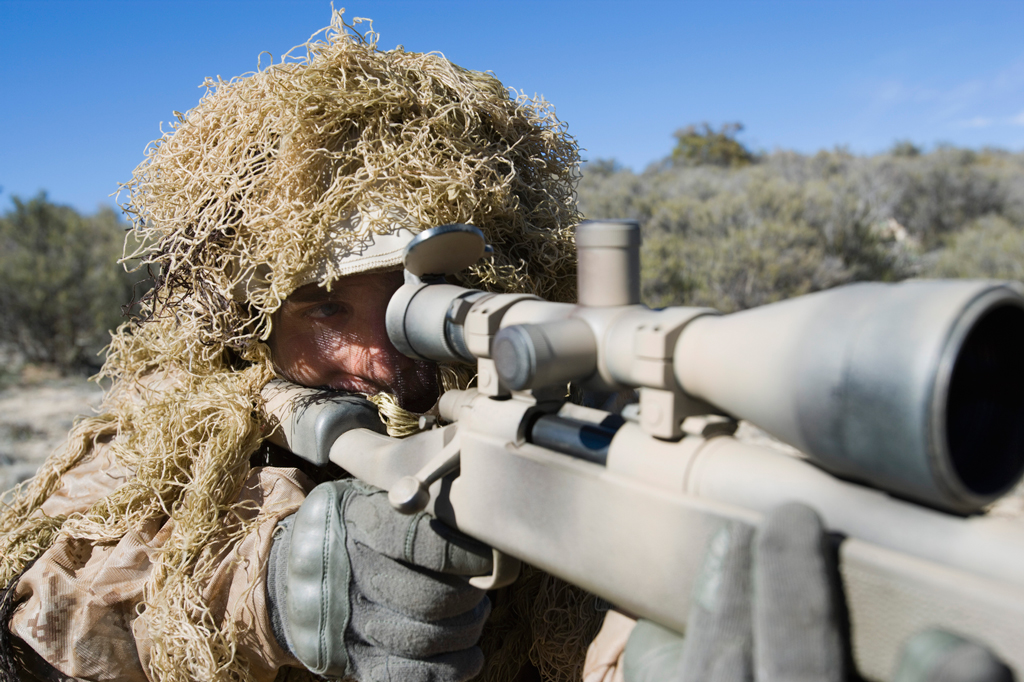
Spetnaz’s Underwater Guns
The Spetnaz’s Underwater RiflesThrough The Years
Story and photographs by Andrew Young

International warfare has created some of the most profound advances in technology and concepts, and the underwater arena is no exception. Following up on last issue’s look at the pistols of combat divers in Russia’s, Germany’s and America’s navies, we dive here into long guns of frogmen.
APS Underwater Rifle
The APS or Avtomat Podvodnyj Spetsialnyj Underwater Rifle was developed during the early 1970s by the Soviet Central Institute for Precision Machine Building (TsNIITochMash plant). The inspiration for this was that Russian combat divers only had knives and the SPP-1 underwater pistol (see American Shooting Journal, June 2015 issue) as their sole means of weaponry. The APS was meant to provide considerably more firepower to their combat divers.


The APS, initially only used by the Russian armed forces, has been available on the international market since the fall of the Soviet Union. It’s based on the AK-74, a refined version of the AK-47 chambered in 5.45×39mm rather than the more commonly known 7.62×39mm of other earlier Kalashnikov rifles, but with several significant changes. It fires a 120mm-long, 5.6mm dart, or flechette, which is relatively stable travelling underwater. The weapon has a smoothbore barrel, and relies on the shape of the flechette for stability and accuracy. The flechette is fired using a standard 5.45×39mm cartridge that has been waterproofed. The polymer magazine holds 26 rounds, and is unusually deep from front to back because the long projectiles dictate its shape.
Like the AK, the APS uses a gas piston to operate; however, this system features a self-adjusting gas valve that allows the weapon to be fired efficiently at varying depths as well as on the surface. Unlike the AK-74 it fires from an open bolt, which ensures that the barrel remains filled with water to properly stabilize the projectiles.

The APS rifle performs differently at different depths because of the increase in water pressure. At greater depths the cyclic rate of the weapon slows down and the muzzle velocity and effective range decreases. At a depth of 16.4 feet, the APS is considered to have an effective range of 98.4 feet, which decreases to 36 feet at a depth of 131 feet.
ASM-DT Rifle
The APS rifle solved the problem of arming Russian divers while they were stationed at a naval base, but the problem still remained on how to arm them when they were deployed on surface missions where the APS was of little or no use. These combat divers ideally required a weapon capable of providing them with the same level of reliability on the surface or underwater.

The divers were faced with the unsatisfactory solution of having to carry separate weapons for each possibility. What they needed was a single hybrid weapon.
In 1991 the Artillery Engineering Institute in Tula, Russia, solved the problem by creating the ASM-DT rifle. This rifle was designed to fire two different types of projectiles. Underwater it fired the same flechette dart as the APS, and when on the surface it fired the standard 5.45x39mm round. The weapon was able to accept both the APS and an AK-74 magazine.

To achieve this duality, the weapon was fitted with a long magazine port and a sliding magazine catch. When the catch was positioned towards the rear of the magazine port, the rifle could accept the APS underwater magazine. When the magazine catch was moved to the middle of the magazine port, the rifle could accept an AK-74 magazine. In this position the rear unused portion of the port was covered with a spring-loaded dust cover. When the magazine release was shifted to the forward position the gas system automatically adjusted for firing underwater.
One of the ingenious alterations was a shallow-groove rifled barrel. This allowed the 5.45x39mm round to be more accurate above water, and also purposely allowed the gases to push ahead of the round in order to blow any remaining water out of the barrel. This prevented the barrel from bursting if the rifle was quickly transitioned from under to above the water without having to drain
it first.

Additional accessories included various types of optical and night sights, as well as tactical lights. The rifle has a folding stock, which along with the pistol grip and handguard are made from impact-resistant plastic. This weapon could also be equipped with a GP-25 grenade launcher, a bayonet or a sound and flash suppressor.
The ASM-DT was not a perfect solution because the diver still had to carry two different types of ammunition and magazines; however, its performance underwater was equal to the APS, and on the surface it performed almost as well as the AK-74. This weapon came into limited service with Naval Spetnaz teams in the Russian Federation Navy in 1980.
ADS Dual-Medium Rifle
The main problem with ASM-DT was that it had to use extremely long, specially designed underwater ammunition when submerged. The rifle needed an overly long receiver, a complicated adjustable magazine well and two types of magazines. The first thing that had to be done was the complete redesign of the ammunition.

The design bureau in Tula went back to the drawing board. This time they developed a more effective underwater round that retained the compact size of the standard issue 5.45×39mm round, and it could be loaded and fired from a standard AK-74-type magazine. This round would also have the ability to be fired through the same chambers and barrels that would accept the above-water ammunition. They called it the 5.45mm PSP round and it was designed with a specific shape that produced a cavitation bubble, which stabilized the round underwater for greater accuracy.
There are two types of PSP ammunition, the 5.45 PSP (combat ammunition) with a hardened-steel projectile weighing 16 grams and an air muzzle velocity around 330 meters per second, and the 5.45 PSP-U (practice and training ammunition) with a bronze projectile weighing 8 grams, and an air muzzle velocity of about 430 m/s. The effective range with PSP ammunition varies from 82 feet at a 16-foot depth to 59 feet at a 65-foot depth. The effective range of the PSP-U training ammunition when below water is about half of the combat round.


When designing the ADS Dual-Medium rifle, the engineers at Tula moved away from the basic AK-74 rifle platform, which had been the base concept for the APS and ASM-DT underwater rifles. The new design was derived from the A-91M Bullpup rifle which had previously been designed at Tula earlier in 1990s. The new weapon retained the bullpup layout, gas-operated action with a rotary bolt action. The gas system was modified with the addition of a manual air/water environment selector. Some parts of the A-91M had to be redesigned and materials were revised to work reliably when submerged in saltwater.

An integral 40mm grenade launcher that fires a VOG-25 caseless grenade can be fitted to this rifle and is fired by using a secondary trigger located inside the trigger guard. The grenade launcher barrel is detachable and can be removed if not required.
The muzzle of the barrel is threaded to accept a muzzle brake or a sound suppressor and is fitted with adjustable iron sights. An integral carrying handle is provided with a Picatinny-type rail on the top to accept various day and night optics. The ADS can fire any standard issue 5.45x39mm ammunition above water with the same accuracy and effectiveness as that from an AK-74 general-issue rifle. When submerged and loaded with 5.45mm PSP ammunition the ADS outperforms both the APS and ASM-DT underwater rifles for accuracy. The ADS came into service with the Russian Navy special forces in 2013.
Currently, there is nothing on record to show that NATO or the United States has developed similar underwater rifles. ASJ



